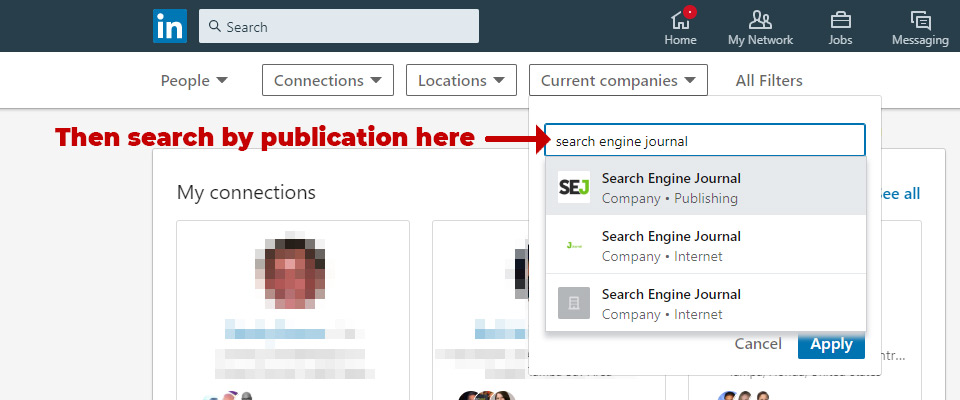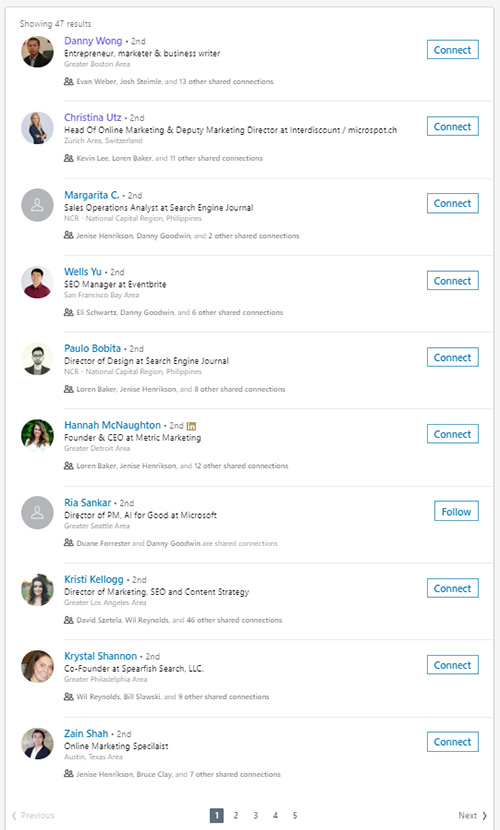We all know that links are a critical part of SEO. Most of us also know just how difficult it can be to earn these links.
You can probably relate.
I’m sure you can remember putting in countless hours trying to find the right people to reach out to, followed by hours carefully crafting and sending your messages.
And then… silence. And you wonder what went wrong.
There are a variety of tools available for link building today.
They range from powerful aggregators that compile contact information of website owners, contributors, and editors, all the way down to a combination of Google, email, and old-fashioned hard work, and everything in between.
Tools are great, but they’re not a magic bullet. The fact is that no such thing exists.
Effective link building to earn the type of links that will survive the fluctuations in search algorithms requires the right tools combined with an effective strategy.
In this article, I’m going to outline a strategy for using LinkedIn to:
- Identify potential link partners.
- Engage with them prior to outreach.
- Finally, ask for the link in a way that dramatically increases your chances of success.
Identify Ideal Link Partners
Have you ever watched a war movie?
You might see troops hauling weapons and equipment around, soldiers loading magazines, and even stealthy spec ops teams quietly infiltrating the enemy position.
And you’ll most certainly see enough savage firefights, rapidly maneuvering vehicles, and explosions to make even Michael Bay drool uncontrollably.
But while we all focus on the exciting parts of the battle, we rarely see the extensive planning that would have been required to conduct that mission.
Frankly, that’s because that part is not very exciting. But this planning is what determines the success or failure of a mission.
Planning will also determine the success or failure of your link building campaigns.
So we want to first use LinkedIn to identify people who may be able and willing to link to our website.
There are two ways to do this.
Seeking Known Opportunities
The first way is to connect with people associated with specific websites.
This means you need to first identify the websites you want a link from, and then use LinkedIn to find people associated with those websites. This might include:
- Owners
- Editors
- Contributors
- People who have previously been featured or interviewed on the website
- Webmasters
This works for commercial, education, and even for government websites.
In fact, I recently used this approach to track down the sole person responsible for the website of a particular large governmental agency. (This person’s title on LinkedIn did not indicate his role, so this case required a unique approach.)
Your situation and goals will determine who is the best person or people to connect with here.
For example, if your goal is to become a contributor, you’ll generally want to connect with the editor. If your goal is to earn a mention and a link, you might want to connect with a contributor or the webmaster.
In the real world, you rarely get to take a direct path though, so you’ll often need to connect with several people in order to eventually get connected to the right person and achieve your goal.
The first step is to search by “People” in the search box at the top of LinkedIn. That option will pop up once you place your cursor in the search box. Simply click that.

The next step is to filter by “Current companies” by entering the name of the publication.

This will return a list of people associated with that publication.

This may not be a complete list, and you may find people listed here who are not actually associated with the publication, so proceed with that in mind.
Identifying New Opportunities
The popular websites on your radar are very likely only a fraction of the relevant, high-quality websites available within your industry. While you certainly should work to earn links from those websites, you shouldn’t overlook the newer or smaller ones.
LinkedIn can be used to find some of these websites that other tools may not identify.
Now you might be thinking, “Why would I waste my time with these newer or smaller websites when there are already more popular ones out there?”
There are two reasons for this. First, they are often low-hanging fruit. In many cases, you can earn a greater number of links with less effort when focusing on these websites.
Second, some of these websites will eventually become just as popular as the ones everyone is focused on today. When that happens, the links pointing to your website will become more powerful, and since you’ll already have an established relationship, you’ll be able to continue earning new links from these websites more easily.
Rather than searching for people associated with a particular website, you’ll search for people in a particular industry and people posting content on particular topics.
This approach comes with an advantage that is actually disguised as a disadvantage. The advantage is that because it can be labor-intensive, fewer of your competitors will put in the effort to use this approach.
It’s more labor-intensive because not everyone you find will have a relevant website that you can earn a link from. You’ll have to manually visit each profile to see if there might be a fit. This creates an opportunity to earn valuable links your competitors have overlooked.
You’ll start in the same way that you did when searching by publications, but this time, you’ll enter a topic in the search field, hit enter, and then click “Content.”

This will return a wide variety of types posts, including people sharing useful information, job postings, and a fair amount of garbage. But many of these people will have a website that’s relevant to yours. presenting some potentially valuable link opportunities.
Engage with Potential Link Partners
Now that we’ve identified the people who might be able and willing to link to our website, it’s time to take action.
It may be tempting to start sending canned direct messages to everyone in a misguided attempt to maximize efficiency.
Don’t do that.
Even though cold pitches on LinkedIn seem to be the hot new trend today, that’s just a really efficient way to piss off a lot of people in a very short period of time.
Instead, treat this like any other relationship. Start by engaging with them in a meaningful way.
This might mean liking and commenting on their posts, and if it makes sense for your personal network, maybe sharing their posts.
You might even tag them in posts where other people are asking questions they might have an answer to or looking for the products or services they offer.
I want to note that if you’re building links on behalf of a client rather than for yourself, you can use their LinkedIn profile for this as long as both you and they fully understand the ramifications.
You need to truly understand their industry and their voice, otherwise, you risk long-term damage to their reputation and personal brand.
The idea here is to first build a relationship based on adding real value over a period of time long before asking for a link.
It’s critical to truly focus on adding value.
This means that you need to skip the insincere “Great post!” type of comments. Everyone can see through that and it’s a complete waste of your time and energy.
Instead, invest the time to post a comment of real substance. Talk about what you learned from their post or how it applies to a specific situation. Offer additional information to support their post. Or, if you can do it tactfully, you can even present a counter-argument.
Sharing their posts with your opinion on key takeaways is another valuable approach, but it’s important to clearly articulate what you found useful in their post. Simply sharing it without substantive context will ring hollow.
And as I’ve mentioned earlier, tagging them where someone is asking a question they are uniquely qualified to answer, or where someone is in need of their products or services goes a long way in developing a strong relationship.
Ask for Earn that Link
Now comes the point we’ve all been waiting for…
Asking for that juicy link.
The asking part is really just the culmination of all the hard work you’ve put in up to this point to earn it. But even at this point, it needs to be handled with finesse because if you fumble here, all of that effort will have been wasted.
Think about this phase the same way you would any face to face business relationships.
You probably know what your friends are up to, right? You know what events they’re planning to attend in the near future.
You know what they’ve been talking about lately. And you might even know what articles they’re writing or planning to write.
The same applies to your contacts on LinkedIn if you’re paying attention.
This can all be useful information in creating an opportunity to earn a link because you can find a way to work a link to your website into what they’re working on.
For example, let’s say that a contact is writing an article about how a new law affects their industry.
If you (or your client) previously wrote an article that supports their position, and you’ve established a relationship by genuinely engaging with them over time, sharing that article as a possible resource for them to cite will often result in a link.
You could also take a more proactive approach by asking people what topics they’re planning on writing about in the near future, or depending on your relationship, you might even suggest certain topics that you already have resources available for them to cite.
More resources:
Image Credits
Featured Image: Modified by author, September 2019
All screenshots taken by author, September 2019
